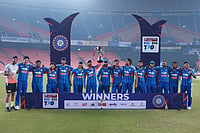Eternal Rival
- Ram Manohar Lohia, who passed away in 1967, was one of the founders of the Congress Socialist Party in 1934 and a member of the secret team leading the Quit India movement, for which he was jailed (1944-46). After Independence, it became his dream to dismantle the Congress hold on Indian politics.
***
The year 1967 was a tumultuous one, holding out myriad possibilities—of both hope and despair—all around the globe. It saw the capture and brutal killing of Che Guevara, as also millions of Americans flooding the country’s streets demanding peace. Expansionist nationalism was being rejected by the masses, but Western governments were going ahead with their ‘secret wars’, undermining democracy in poorer countries. If there were inspiring moments, there were grave setbacks too.

Virendra Kumar Sakhlecha (left) being sworn in as CM of Madhya Pradesh in 1978
In 1967, events in China also beckoned India in a different direction. A peasant revolt in a small village called Naxalbari was to create (and lend its name to) a seductive idea with nationwide resonance. It would draw towards it some of the best minds from prestigious institutions. They were confident that ‘revolution’ was around the corner. Fifty years hence, the idea would still survive, but unrecognisable and in a hundred splintered forms. There would still be revolutionaries in jungles, shaming the urbanites.
To think Naxalbari has become irrelevant would be a folly. If a learned man like Manmohan Singh could call it the biggest threat to the country and if the current regime feels the need to delegitimise it by calling it ‘anti-national’, one would have to say there is still some life in it. That the ruling regime wants the poet Avtar Singh Sandhu ‘Pash’ out of the reach of the children or youth—which it seeks to ensure by calling him a Naxalite and hence ‘unpatriotic’—is in itself proof that it still remains a destabilising idea for the establishment.
Naxalbari, however, was not the only extra-parliamentary opposition to the Indian polity that season. On November 7, 1966, an army of ‘gau rakshaks’ organised by the Rashtriya Swayamsevak Sangh (RSS) had stormed Parliament. Nehru had warned the secretaries of the government of India in his last meeting with them, as Y.D. Gundevia recalls in his memoir Outside the Archives, “The danger to India, mark you, is not Communism. It is Hindu right-wing communalism.”
The first major intervention of Hindutva majoritarianism was, thus, staged from outside the negotiating space of parliamentary politics, forcing its way in. It was later to be echoed and surpassed by the Babri Masjid demolition campaign, led by L.K. Advani, who admitted the movement was not religious, but political in nature and intent. Similarly, his guru M.S. Golwalkar had, in an intimate moment, confessed before the great milk cooperatives icon Verghese Kurien that the anti-cow slaughter movement was essentially political.

Chaudhary Charan Singh (left) was prime minister from July 1979 to January 1980, preceding Indira Gandhi’s (right) return to power
An experiment that was duller compared to Naxalbari, yet significant and more decisive in the longer term, was thus begun using the parliamentary path that the Naxals derided. The radical left perhaps lacked tactical imagination. The RSS did not. It had the Bharatiya Jan Sangh in the parliamentary arena and remained focused on creating an ecosystem conducive to it in the larger social and cultural fields. As was evident from the election results of 1967, its efforts paid off.
For, the year saw a major upheaval in the elections to state assemblies. The citadels of the Congress were shaken for the very first time since Independence. Having been comfortably ensconced in power for those first 20 years after 1947, almost as a natural inheritor of post-colonial India, it was finally jolted out of its complacence. Its majority in the Lok Sabha was considerably reduced. And of 16 states, eight rejected it. Two of them, Kerala and Orissa, chose a leftist and rightist coalition respectively. The Dravida Munnetra Kazhagam (DMK) replaced the Congress in Madras. In West Bengal, Bihar, Rajasthan, Uttar Pradesh and Punjab, the Congress hold was eroded and, despite remaining the single largest party, it fell short of the required majority to form governments on its own.
The comprehensive nature of these first genuine electoral setbacks for the Congress can be gauged if we look back to see its leading lights like Kamaraj and Atulya Ghosh being defeated along with the PCC presidents in six states and chief ministers in four states.
Congress dominance—or the ‘Congress system’, as Rajni Kothari called it—was broken in a decisive manner. Nehru had already been dead for three years. His successor Lal Bahadur Shastri’s untimely death had propelled Indira Gandhi to leadership. The party’s old guard had counted on being able to manipulate the ‘goongi gudiya’ (mute doll), as Ram Manohar Lohia called her derisively, but she marked time and gradually eased them out. The party had to split.

Karpoori Thakur’s first stint as Bihar CM was from December 1970 to June 1971
In 1967, Indian parliamentary democracy was still young. But the looming shadow of the Congress had imparted to it a jaded look. The romance of the teens was over. Poet Dhumil would look at the tricolour and call freedom a ‘tired wheel’. Impatience was building up. Something was rotten in the system. The hope of Maila Anchal and Parati Parikatha was to give way to the cynicism of Raag Darbari.
This cynicism and impatience led people to experiment with the unknown. Why this was remarkable can be understood if we look at the disparate political forces battling the well-oiled Congress machinery. There was no concept of TINA then. The people of India were ready for uncertainties.
There was, however, a background to all this. Hiranmay Karlekar, then writing in The Harvard Crimson, explained the disenchantment of the people with the Congress. Despite an unchallenged rule for 20 years, the Congress-led government had not succeeded in solving the problem of food shortage. It had become even more acute after an unprecedented drought in Bihar, Orissa and Uttar Pradesh. Old-timers remember Prithviraj Kapoor moving across India with his drama troupe to raise relief for the affected. It was an ordeal to secure even daily essentials. Prices were beyond the control of the government. India was still in an era of rationing.
It seemed as if the Congress had lost the plot. The rupee had to be devalued. An impression gained ground that the government had succumbed to the pressure of Western powers. Karlekar pointed out that the message from Parliament was also dismal for the ruling Congress. Despite being in a comfortable majority, it could not respond to a small but aggressive Opposition. A feeling of stagnation at the Centre, the sense of things falling apart everywhere.
This was the background in which the Socialists, the Communists and the communalists, all came together to realise Lohia’s dream: to break the monopoly of the Congress over Indian democracy. Once the blued-eyed boy of Nehru, Lohia was to turn the biggest foe of his party. Ironically, after dismantling the Congress hold on the Indian polity, Lohia was not to live long to see what his people were doing.

Govind Narayan Singh, MP CM, 1967-69; Ram Manohar Lohia
The emergence of the anti-Congress coalition should be seen mainly as a reflection of the weakening of the Congress from within. In its monopoly years, it had grown arrogant and ignored heretic voices within. Trying to solidify itself thus, the Congress was ironically harming itself. Dissenters, kept away from important positions, were forced to part ways and form their own parties. Secret alliances with the Opposition to upset the official Congress also played a part.
The person hounded out of the party in West Bengal became the chief minister after ousting the Congress from power. Similarly, in Bihar, an ex-Congressman took over as chief minister after the coalition’s victory in the elections. In Orissa too, it was the Jana Congress, a breakaway faction of the party, that replaced the Congress along with C.R. Rajagopalachari’s Swatantra Party.
The coalition governments did not last. Their stint in power did not see any major intervention at the policy level. Nor did they bring about a new language of governance. The coming together of the Left and the Right, with the narrow aim of ousting the Congress, could have led to a new policy consensus. That did not happen.
The biggest gainer of the coalition experiment was to be the RSS and its political wing, the Jan Sangh. It captured Delhi, a major symbolic victory, shattered the Congress in Madhya Pradesh and enhanced its strength considerably in Uttar Pradesh. Exactly 10 years later, the Jan Sangh was to collaborate again with the socialists, conservatives and a faction of the Left to topple the Congress and further entrench itself in parliamentary politics. Socialists believed in the dictum of Lohia, to keep splitting like amoeba and revolting against one’s own government.
The loser of the 1967 experiment was the Left. It could not surpass its existing strength. It ceded the position of the main Opposition to the Jan Sangh. Also, in becoming an obedient parliamentary political force that avoided the risk of taking an extra-parliamentary path, it somewhere started losing its original motivation—of forming its politics from the crucible of people’s struggles—and became predictable. It was satisfied playing a supporting role. It was to lose national appeal and happily agreed to be a party of three states. It was never a contender for power nationally. Looking back today, one can say safely 1967 was the beginning of a definite rightward shift in Indian politics.
Apoorvanand teaches Hindi at the University of Delhi


























